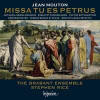Texte paru dans: / Appeared in:

Fanfare Magazine: 36:2 (11-12/2012)
Pour
s'abonner / Subscription information
Les abonnés à Fanfare Magazine ont accès aux archives du
magazine sur internet.
Subscribers to Fanfare Magazine have access to the archives of the magazine
on the net.
Hyperion
CDA67933

This is the only currently available album in the U.S. record catalog devoted entirely to music by Jean Mouton, and one of two if we include another disc that offers Compère’s chanson Dictes moy toutes vos pensées. They share only the motet Nesciens mater, in any case, so this CD offers value on the grounds of simple availability, with nothing else factored in.
There’s a great deal to enjoy here, even allowing for the occasional duplication. The Ave Maria, gemma virginum is a quadruple canon on the octave, a fine example of craftsmanship that coexists alongside and furthers the goal of producing a richly supplicatory work. Nesciens mater is an object lesson in structuring a perfect quadruple canon at the upper fifth, with a distance of entry of two breves. Exsultet coniubilando is a commemorative motet in honor of Pope Leo X, using two cantus firmi. It demonstrates the wealth of textures and contrapuntal devices (including, inevitably, canons) Mouton could employ to give an impression of unending glorification in just over four minutes. Notable, too, is the way the composer places brief but bold progressions across an essentially static harmonic landscape, to excellent effect. This is the Franco-Flemish tradition at its best.
Two four-voiced motets are included. Factum est silentium is Michael fighting the dragon, and Mouton colors his usual, even-pressured counterpoint with sudden bursts of harmonically distinctive homophony—most obviously at “Salus, honor et virtus omnipotenti Deo,” which is bound to raise the short hairs of any early listener, in a strictly good way. Bona vita, bona refectio qualifies as a sacred motet, given its holy subject, but the worship of Christ is put in the mouths of a group of priests celebrating “good life, good health, good feast, good drink, good joy.” Mouton lightens his manner for this chanson rustique with varied rhythms, popular harmonic cadences, and a broader, less involved use of his freight of technique.
The Missa Tu es Petrus is Mouton’s only extant Mass in five parts, with the gently affirmative cantus firmus chant given here to the women. It is another work of extraordinarily inventive craftsmanship, one in which contrapuntal craft, and a very few changes in texture, form the currency of musical exchange. Rice’s decision to give the three-voiced Benedictus to three of the Brabant Ensemble’s women as soloists is excellent, and one I could wish he had employed as well in the four-voiced Christe eleison and Crucifixus, still treated sectionally.
The Brabant Ensemble represents a tradition that balances the voices for an overall, homogenous sound of great beauty. Rice aims for textural clarity and intonational perfection, and this he and his performers achieve in spades. They do not treat the text as an expressive device, at least not to my ears, relying upon the compositional setting to achieve this. If you like that approach, you will find much to enjoy here. Another possible point of contention is the use of 17 singers. I find that in music as complex as this the sheer numbers tend to cloud the textures, something that immediately clears up in the Missa Tu es Petrus’s Benedictus. Some of it may be a matter of the resonant recording venue, but whatever the cause, I can’t help thinking that a smaller number of performers could have brought out Mouton’s remarkable skill without sacrificing any of the sonic splendor the Brabant Ensemble achieves.
Those issues
aside, I have nothing but praise for Rice and his singers. Their pacing is
solid, and their discipline appreciable. They are precise, yet phrase under
Rice’s direction with a refined awareness for the musical line. Strongly
recommended, with reservations noted.
Fermer la fenêtre/Close window
Cliquez l'un ou l'autre
bouton pour découvrir bien d'autres critiques de CD
Click either button for many other reviews



